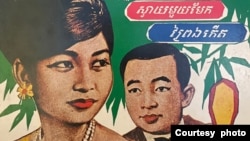When Los Angeles film producer Greg Cahill embarked on a graphic novel project to document the life of legendary Cambodian singer Ros Serey Sothea, he struggled for months to find an illustrator who could bring his vision to life.
He finally found her — Kat Baumann — 1,800 miles away in Mankato.
More on Kat in a moment. To understand why she’s involved in a graphic novel called “The Golden Voice” about a 1970s Cambodian singer written by an LA film producer, some context is in order.
Ros Serey Sothea’s story means a lot to Cahill.
“This really goes back to my childhood,” he said. “When I was 2 or 3 years old, my parents were involved in helping a big group of Cambodian refugees who had just come to the United States.”
They’d come because of the Khmer Rouge, the brief but brutal communist regime in Cambodia that executed more than a million people. Artists were particularly targeted. Singer Ros Serey Sothea, one of the most beloved, was among the casualties.
Cahill’s parents were part of a group that helped the refugees, the Mankato Free Press reported.
“When I was 3, my parents had this big party in our backyard for all the refugees who had just arrived from Cambodia,” he said. “It made a big impression on me.”
Several years ago he produced a short film about the singer. But he’d always thought her story deserved a larger audience and more notoriety. So he decided to try telling her story via graphic novel.
Cahill isn’t an artist, so he started searching for one.
Enter Kat Baumann.
“I spent a long time trying to find the right artists for this project. And it was months and months of dead ends with different artists,” he said. “I finally reached out to someone that I knew in LA and said, ‘Hey, do you know anyone who would be good for this graphic novel?’ He was kind enough to put out a Twitter blast. And I got responses from about 100 artists at that point. And at the top of the list was Kat Baumann.”
Baumann is somewhat well-known in southern Minnesota. Her illustrated feature “Community Draws” appears monthly in Mankato Magazine. She’s tapped regularly to design pledge drive T-shirt logos for Minnesota State University’s public radio station, KMSU 89.7-FM. She did a T-shirt design for last year’s Mankato River Ramble. She also sings in a variety of bands.
But this was her first graphic novel. And even though Cahill was nearly 2,000 miles away, she said the collaborative process went smoothly.
The nice part for Baumann is that Cahill had already done all the research and came up with rough sketches for how he wanted many of the designs to look. She’d take his ideas, come up with her own rough sketches, send them back for edits, then produce full-color versions.
All told, the project took about two years. And in the end, both Baumann and Cahill say they were extremely happy with how it turned out.
“When I set out to do a graphic novel, I had an expectation, but she just blew it out of the water and really elevated the story,” he said. “And anytime I show her work to anyone you just see their face light up, and they’re like, ‘Oh, my God!’ So I was very lucky to cross paths with Kat.”
Little is known about Ros Serey Sothea’s death. Her death, in fact, has never been confirmed, but according to her Wikipedia entry, many believe she was executed soon after the Khmer Rouge came to power; the regime was said to loathe entertainers.
Mystery, however, surrounds her death. Multiple stories offer alternative endings. One says that, as the Khmer Rouge took over, the outgoing government whisked her away to protect her. Still another says Pol Pot, the Khmer Rouge dictator, captured and forced her to perform for a time before she was ultimately executed.
Cahill’s interest, though, is with the impact she had on the Cambodian people as a performer. She’s said to have recorded hundreds of songs, although many of her recordings were lost in the tumult of regime change and genocide.
Cahill first heard Ros Serey Sothea in a film called “City of Ghosts,” written and directed by Matt Dillon. The film, the first shot on location in Cambodia since the Khmer Rouge regime, is full of footage of Cambodian music from the 1970s.
“It’s sung in the Khmer language,” he said. “And my favorite singer on the soundtrack was Ros Serey Sothea. I loved her music, but I didn’t know anything about her. So when I started learning about how all of the musicians from that music scene at that time had been killed in the genocide, it seemed like not only was this music amazing, but there was a very important history behind it.”
He began doing research on her in 2006 and produced a short film about her. That film, though, only made him want to do something more to educate people about Ros Serey Sothea.
Like Cahill, Baumann was satisfied with not only the result, but also the collaborative nature of the work.
“I was really excited with how a lot of this book turned out,” she said. “I feel like I’m really finding my visual style in just drawing in the medium a little bit better.”
The novel was finished within the last few months. Cahill is shopping the book around to publishers, but he says it’s not a matter of if it gets published, but when.




